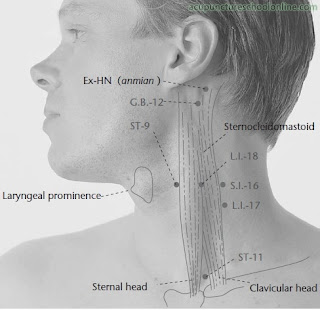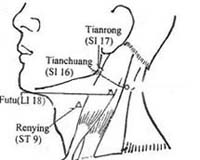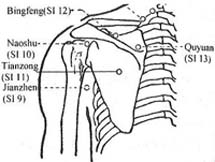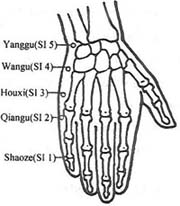Greater Yang Small Intestine Channel
PRIMARY CHANNEL
Starts at the ulnar side of the tip of the little finger and ascends along the u1nar side of the
hand to the wrist, emerging at the styloid process of the ulna. Goes directly upwards along the
posterior aspect of the ulna, passing between the:olecranon of the ulna and the medial epicondyle of
the humerus at , the elbow. Then proceeds along the posterior border of the: lateral aspect of the
upper arm, emerging behind the shoulder joint and circling round the superior and inferior fossa of
the scapula.
At the top of the shoulder it crosses the Bladder channel at points UB 41 and UB 11, and the
DU channel at DU 14, where the channel turns downward into the supraclavicutar fossa and
connects with the Heart. From here; it descends along the esophagus and crosses the diaphragm to
the Stomach. Before reaching its associated organ, the Small Intestine, the channel intersects the
Conception channel internally, and very deep; at points Ren 13, and Ren 12.
A branch of this channel travels upward from the supraclavicular fossa and crosses the neck and
cheek to the outer canthus of the eye, where it meets the Gall Bladder channel at GB 1. Then it turns
back across the temple and enters the ear at SI 19:
Another branch separates from the former branch on the cheek, ascends to the infraorbital
region of the eye and then to the inner canthus, where it meets with the Bladder channel at UB 1. It
then crosses horizontally to the zygomatic region.
Another branch descends to ST 39, the Lower He-Sea of the Small Intestine.
This channel connects with the Heart and directly joins the Stomach.
CROSSING POINTS: UB 1, UB 11, UB 41, GB 1, TB 22, Ren 12, Ren 13
SYMPTOMS ASSOCIATED WITH THE EXTERNAL COURSE OF THE CHANNEL
Numbness of the mouth and tongue, pain in the neck or cheek, sore throat, stiff neck, pain along
the lateral aspect of the shoulder and upper arm.
SYMPTOMS ASSOCIATED WITH THE INTERNAL ORGAN
Pain and distension in the lower abdomen, possible extending around the waist or to the
genitals, diarrhea or abdominal pain with dry stool and constipation.
DIVERGENT CHANNEL
After separating from the primary channel at the shoulder, this channel enters the axilla, crosses
the Heart, and descends to the abdomen, where it connects with the Small intestine.
Arm Greater Yang Small Intestine Channel
LUO CHANNEL
After separating from the primary at SI 7 this connects with the Heart channel at Ht 7. Another
branch continues up the arm, crosses the elbow, and joins with the shoulder.
Symptoms of Excess: looseness in the joints, atrophy of the muscles in the
elbow and arm
Symptoms of Deficiency: long, finger-shaped warts, scabies
MUSCLE CHANNEL
Begins of the dorsum of the little finger, connects at the wrist, and ascends along the
forearm to the: elbow, where it connects with the medial condyle of the humerus. From here, the
channel proceeds up the arm and connects below the axilla.
A branch travels behind the axilla, surrounds the scapula, and follows in front of the Bladder
muscle channel on the neck, connecting behind the ear. A branch separates behind the auricle and
enters the ear itself. After emerging above the auricle, this branch descends across the face and
connects beneath the mandible, then ascends to connect at the outer canthus and temple.
Another branch separates at the mandible, ascends around the teeth and in front of the ear,
connecting at: the outer canthus and the angle of the natural hairline.
Pathological Symptoms:: stiffness or pain in the muscles of the little finger, pain along the
medial and; posterior aspects of the elbow, pain below and on the posterior aspect of the axilla
caused by pulled muscles along the medial aspect of the arm, pain in the neck caused by pulled
muscles surrounding the scapula, tinnitus related to ear ache, pain reaching from the ear to the
mandible, poor vision:
If there are spasms in the muscles of the neck it is due to weakness or atrophy of this muscle
channel. Swelling on the neck along the course of this channel may be related to the presence of
Cold or Heat.
SUMMARY: SMALL INTESTINE CHANNEL
Phone # (476) S.I.-1-2-3-5-8
Tonification point: S.I. 3
Sedation point: S.I. 8
Horary point: S.I. 5
S.I. 1 breast/ HA's/ eyes & mucus membranes
S.I. 3 relaxes muscles/ neck & back pain/ arthritis & joints/ HA's/ spirit point
S.I. 6 similar to S.I. 3-- neck & back pain/ vision & red eyes
S.I. 7 Spirit/ depression/ anxiety
S.I. 17 Sore throat/ tonsillitis
S.I. 19 local/ spirit/ ear stuff












































